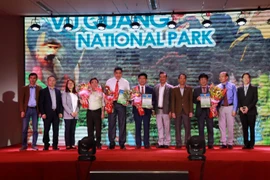 "My Diem Hong Nam Dong” (Hemiboea thanhhoensis), a plant species recently discovered in the Nam Dong gymnosperm conservation area in Quan Hoa district, Thanh Hoa province (Photo: VNA)
"My Diem Hong Nam Dong” (Hemiboea thanhhoensis), a plant species recently discovered in the Nam Dong gymnosperm conservation area in Quan Hoa district, Thanh Hoa province (Photo: VNA)Hanoi (VNA) – Deputy Prime Minister Trinh Dinh Dung recently signed Decision 174/QD-TTg that approves the task of building a biodiversity conservation plan for 2021 – 2030, with a vision to 2050. The future plan will be implemented across the Vietnamese territory, including the mainland, seas and islands.
The planning targets nature reserves, biodiversity corridors, biodiversity conservation facilities, areas with high biodiversity, important ecological landscapes, and important wetlands.
It must match the related overall national plan, the national land use plan, the national maritime spatial plan, and the strategy for sustainable development of Vietnam.
[Biodiversity conservation, tourism combined in national park]
The planning will assess natural and socio-economic conditions affecting biodiversity of ecological zones in mainland and sea areas, the biodiversity status of ecological zones in mainland and seas areas, along with the status of coral reefs, seagrass meadows and upwelling zones.
It will also evaluate the status of those subject to the biodiversity conservation plan, draw maps of the status of biodiversity and those subject to biodiversity conservation for each ecological zone, and create maps of priority areas for biodiversity conservation for each ecological zone during the 2021 – 2030 period.
The work will forecast biodiversity trends in the period, along with pressures of the development and exploitation activities on the biodiversity of mainland and marine ecosystems.
Besides, it will specify concrete targets of biodiversity conservation for the whole nation as well as for each ecological zone; targets relevant to those covered by the plan; as well as names, geographical locations, areas, and management of those under coverage.
It will also build development plans and measures for organising, managing and sustainably developing each of those subject to the biodiversity conservation plan.
[Exploring nine Ramsar sites of Vietnam]
To perform the tasks, the Ministry of Natural Resources and Environment is responsible for detailing the zoning content and budget and selecting plan building units in line with regulations.
It was also assigned to coordinate with other relevant ministries, sectors, agencies and organisations to carry out quality and effective planning on schedule.
Data show that Vietnam is home to about 20,000 plant species, more than 10,500 terrestrial animal species, over 2,000 invertebrates and freshwater fish species, over 11,000 marine species, and about 7,500 microorganisms.
However, rapid urbanisation, unplanned development, changes in land use methods and infrastructure building have shrunk the biotope area considerably and degraded the habitats of many wild fauna and flora species.
Facing that fact, the Ministry of Natural Resources and Environment has built and submitted a national action plan on the conservation and sustainable use of wetlands for 2020 – 2030 that aims to protect the “cradle” of biodiversity.
Under this national action plan, by 2030, the country will have to ensure that all of its important wetlands will have been managed, conserved and used sensibly, 25 percent of the area of important wetlands recovered, at least 10 wetland reserves set up, and at least five more sites given the Ramsar (wetland of international importance) title.
There are nine Ramsar sites in Vietnam at present, namely Xuan Thuy National Park (Nam Dinh province), Bau Sau Wetlands and Seasonal Floodplains of Cat Tien National Park (Dong Nai province), Ba Be National Park (Bac Kan province), Tram Chim National Park (Dong Thap province), Mui Ca Mau (Ca Mau Cape) National Park (Ca Mau province), Con Dao National Park (Ba Ria – Vung Tau province), Lang Sen Wetland Reserve (Mekong Delta), U Minh Thuong National Park (Kien Giang province), and Van Long Wetland Nature Reserve (Ninh Binh province)./.






























